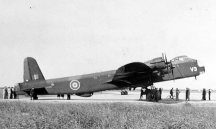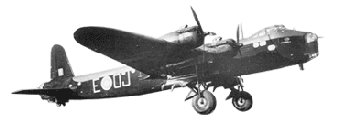
Short Sterling
Short's Stirling is one of the unsung heroes of the war. This large aircraft was Britain's first four-engine monoplane bomber to enter service. It became a stalwart of the night bombing campaign over Europe, even though it was never given as much credit as the better known Lancaster and Halifax. First entering service with No.7 Squadron in February 1941, the Stirling flew on Bomber Command's major raids until September 1944.
A bulky, four engine bomber, the Stirling was especially heavy for its tailwheel landing gear. It became an important participant in the war over the European continent.
The stirling has been called the 'ugly duckling' of Royal Air Force bombers and is deemed by many not to have reached its full potential. Facing flak and fighters, many Stirling crews feared their plane was a firetrap. This negative reputation was exaggerated many crewmembers had great confidence in what was in most respects, a fine aircraft.
After bloody battles on bombing sorties against ferociously defended targets, from early 1944 the Stirling's primary role changed to glider tug and transport.
Towing troop-carrying gliders, Stirlings had an important role in the Normandy invasion. Thereafter, Stirlings hauled gliders for the failed airborne operations at Arnhem and the March 1945 crossing of the Rhine.
By March 1946, most Stirling squadrons had been disbanded or had converted to other aircraft and the last Stirling was retired from Royal Air Force service.
Stirlings were operated by 11 Bomber Command squadrons, made 18,440 sorties, dropping 28,268 tonnes (27,821 tons) of bombs and laid about 20,000 mines. Of the 2369 production Stirlings, 769 were lost, including 641 in action. During 1947 two dozen Stirling Mk Vs were converted as cargo and passenger aircraft for a Belgian operator.
 |
 |
 |
| Stirling Mk I of No.7 Squadron, the first unit to equip with the heavy bomber, receives its load of bombs. |
With its long, narrow fuselage bomb-bay that was divided into four sections, the Stirling was not able to carry a worthwhile bombload on very long-range missions. |
With a top speed of 435 km/h (269 moh) and a maximum all-up weight of 31,751 kgs (69,938 lbs), the Stirling was handicapped by its low service ceiling. |
|
Short Sterling (Technical Specification) |
| Role |
Seven-place heavy bomber with a crew of seven or eight |
| Manufacturer |
Short |
| Maximum Speed |
435 kmh (270 mph) |
| Maximum Range |
950 km (590 miles) |
| Ceiling |
5,180 meters (17,000 feet) |
Weight
Empty
Maximum Takeoff |
19,595 kg (43,109 lbs)
31,751 kg (69,938 lbs) |
Dimensions
Wingspan
Length
Height
Wing Area |
30.20 meters (99 ft)
26.59 meters (87 ft 3 in)
6.93 meters (22 ft 9 in)
135.63 square meters (1,482 sq ft) |
| Engines |
Four Bristol Hercules VI or XVI radial piston engines each providing 1230-kW (1,650-hp) |
| Armament |
Eight 7.7 mm (0.303 cal) Browning machine-guns in Frazer-Nash FN.5A nose turret (two), FN.7A dorsal turret (two) and FN.20A tail turret (four)
6,350 kgs (14,000 lbs) of bombs |
Photo Gallery
Click here to submit your photo
| Have A Passion For Aircraft? |
Subscribe to our 14 series FREE newsletter
delivered weekly on World War 2 Aircraft factfile... |
| NB:- We hate spam as much as you do, so your email address will NEVER be shared with or sold to anyone else. That's a Guarantee. |
|
|





